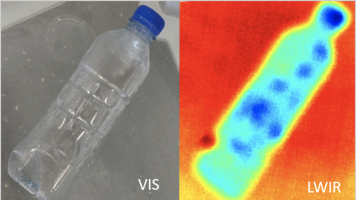
Closed
Our idea is to study the potential of measuring thermal infrared radiance as a novel remote sensing technology for floating plastic litter. It is based on the different emissivity values of water and plastic. The emissivity of water is very high, near one, and of plastics it is generally lower. The thermal infrared signal is expected to improve with a lower value of plastic emissivity, enhanced by an increasing temperature difference between air and sea. Remote sensing of marine plastic litter is still in developing stages and most progress has been made in the field of spectral remote sensing using visible (VIS), near infrared (NIR) and short-wave infrared (SWIR) wavelengths where optical physics applies. However, it has become clear that spectral remote sensing would benefit from complementary measurements using different sensing technologies. Thermal sensing operating in the long-wave infrared (LWIR) is thought to be one of those technologies. We plan to develop a thermal radiance model for floating plastic litter and verify this model with an LWIR camera in laboratory and field experiments. In addition, the LWIR camera could be mounted on an aircraft or drone and flown over plastic polluted water. A next step would be developing remote sensing algorithms for detection of marine plastic pollution based on LWIR bands and applying these to satellite based observations. ESA could use our findings to develop satellite missions specifically designed for monitoring marine plastic. They could also apply a remote sensing algorithm based on thermal infrared sensing to measurements from space that are already available, for example from Sentinel-3. The OLCI ocean colour instrument with 21 bands in the VIS-NIR on Sentinel-3 works in synergy with Sentinel-3′s SLSTR instrument comprising six bands in the VIS-SWIR and three in the thermal IR ambient bands. Hence, this idea has the possibility to progress from theory all the way up to applications in satellite remote sensing.
